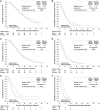Biomarker analysis beyond angiogenesis: RAS/RAF mutation status, tumour sidedness, and second-line ramucirumab efficacy in patients with metastatic colorectal carcinoma from RAISE-a global phase III study
- PMID: 30339194
- PMCID: PMC6336001
- DOI: 10.1093/annonc/mdy461
Biomarker analysis beyond angiogenesis: RAS/RAF mutation status, tumour sidedness, and second-line ramucirumab efficacy in patients with metastatic colorectal carcinoma from RAISE-a global phase III study
Abstract
Background: : Second-line treatment with ramucirumab+FOLFIRI improved overall survival (OS) versus placebo+FOLFIRI for patients with metastatic colorectal carcinoma (CRC) [hazard ratio (HR)=0.84, 95% CI 0.73-0.98, P = 0.022]. Post hoc analyses of RAISE patient data examined the association of RAS/RAF mutation status and the anatomical location of the primary CRC tumour (left versus right) with efficacy parameters.
Patients and methods: Patient tumour tissue was classified as BRAF mutant, KRAS/NRAS (RAS) mutant, or RAS/BRAF wild-type. Left-CRC was defined as the splenic flexure, descending and sigmoid colon, and rectum; right-CRC included transverse, ascending colon, and cecum.
Results: RAS/RAF mutation status was available for 85% of patients (912/1072) and primary tumour location was known for 94.4% of patients (1012/1072). A favourable and comparable ramucirumab treatment effect was observed for patients with RAS mutations (OS HR = 0.86, 95% CI 0.71-1.04) and patients with RAS/BRAF wild-type tumours (OS HR = 0.86, 95% CI 0.64-1.14). Among the 41 patients with BRAF-mutated tumours, the ramucirumab benefit was more notable (OS HR = 0.54, 95% CI 0.25-1.13), although, as with the other genetic sub-group analyses, differences were not statistically significant. Progression-free survival (PFS) data followed the same trend. Treatment-by-mutation status interaction tests (OS P = 0.523, PFS P = 0.655) indicated that the ramucirumab benefit was not statistically different among the mutation sub-groups, although the small sample size of the BRAF group limited the analysis. Addition of ramucirumab to FOLFIRI improved left-CRC median OS by 2.5 month over placebo (HR = 0.81, 95% CI 0.68-0.97); median OS for ramucirumab-treated patients with right-CRC was 1.1 month over placebo (HR = 0.97, 95% CI 0.75-1.26). The treatment-by-sub-group interaction was not statistically significant for tumour sidedness (P = 0.276).
Conclusions: In the RAISE study, the addition of ramucirumab to FOLFIRI improved patient outcomes, regardless of RAS/RAF mutation status, and tumour sidedness. Ramucirumab treatment provided a numerically substantial benefit in BRAF-mutated tumours, although the P-values were not statistically significant.
Clinicaltrials.gov number: NCT01183780.
Figures


References
-
- Tabernero J, Yoshino T, Cohn AL. et al. Ramucirumab versus placebo in combination with second-line FOLFIRI in patients with metastatic colorectal carcinoma that progressed during or after first-line therapy with bevacizumab, oxaliplatin, and a fluoropyrimidine (RAISE): a randomised, double-blind, multicentre, phase 3 study. Lancet Oncol 2015; 16(5): 499–508. - PubMed
-
- Yoshino T, Obermannová R, Bodoky G. et al. Baseline carcinoembryonic antigen as a predictive factor of ramucirumab efficacy in RAISE, a second-line metastatic colorectal carcinoma phase III trial. Eur J Cancer 2017; 78: 61–69. - PubMed
-
- Obermannová R, Van Cutsem E, Yoshino T. et al. Subgroup analysis in RAISE: a randomized, double-blind phase III study of irinotecan, folinic acid, and 5-fluorouracil (FOLFIRI) plus ramucirumab or placebo in patients with metastatic colorectal carcinoma progression. Ann Oncol 2016; 27(11): 2082–2090. - PMC - PubMed
Publication types
MeSH terms
Substances
Associated data
LinkOut - more resources
Full Text Sources
Medical
Research Materials
Miscellaneous

